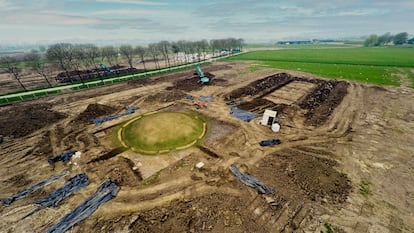‘Dutch Stonehenge’ reveals 4,000-year-old solar calendar
The site in Tiel has been compared to the megalithic monument in England and among the artefacts uncovered is crystal bead that traveled 3,100 miles from Mesopotamia


Some 4,000 years ago, during the late Stone Age and early Bronze Age, the Rhine River served as a natural corridor for the populations of northwestern Europe. It was a route for trade and the exchange of ideas, a kind of prehistoric highway that has left the remains of open-air sanctuaries, some of which also served as a solar calendar. In the municipality of Tiel, one such enclave has been discovered, unique in the Netherlands, with three earthen mounds and wooden pylons forming aisles for ritual processions. The site has been excavated since 2017 and was presented this June. Among the objects discovered was a glass bead from Mesopotamia (present-day Iraq) that demonstrates contact with people from the Ancient Near East. Despite the absence of stone in the Dutch delta, the site has been compared to Stonehenge, the megalithic monument located in England. Both marked solstices and equinoxes and both witnessed human burials.
The size of the shrine at Tiel, about 50 kilometers (31 miles) from Utrecht, is equivalent to three soccer stadiums and archaeologists realized a few months ago that the largest of the mounds they had uncovered was a solar calendar. About 20 meters in diameter, a trench had been dug around it with openings through which the sun entered on specific dates of the year, as at Stonehenge. “For example, the sun’s rays would mark June 21, the summer solstice, and the longest day of the year. Or December 21, the winter solstice and the shortest day,” explains archaeologist Cristian van der Linde, the discoverer of the site, whose team worked in tandem with municipal experts.

This space also marked the beginning of spring and autumn: March 21 and September 21, when day and night are of the same length. “In our current calendars there are still dates that are based on the solar calendar: Christmas, for example, is associated with the longest night. Or the May festivals celebrated between the vernal equinox and the summer solstice,” says Van der Linde. The site at Tiel was used for some 800 years. “We think the movements of the sun were related to their religious beliefs; that’s why there are about 80 people buried here,” says the archeologist. The sun not only illuminated the living: in the graves objects were found that are believed to offerings, such as a bronze spearhead.
The solar calendar is very complete and Van der Linde believes that it was used it to calculate how long the winter would last, and the ideal time for sowing grain and the subsequent harvest. “It was a tool for survival and for worship, which leaves us with a unique image of Bronze Age customs in our territory. We have recovered about one million objects,” he says. During the excavations, researchers also uncovered four inhabited areas, one of which was located about 20 meters south of the burial ground. The others, all wooden houses with space for families and animals, were scattered along a ravine. “There must have been as many as 100 people living there, although beyond the surveyed part there could have been more farms,” notes the expert.

And the glass bead from the East? “It is a sign. We know that there were extensive trade routes and the bead is the oldest found in a very large area. In addition, it is 500 years older than other similar ones collected in northwestern Europe and reflects how objects moved around the world.” However, Van der Linde rules out these traders traveling to Mesopotamia and bringing the piece back themselves. “There were networks that covered as much as 1,500 kilometers (932 miles) of distance and the exchange took place where those networks crossed. In any case, 4,000 years ago people were moving around a lot more than perhaps we think.”
Following completion of the excavations, the artifacts uncovered have been cataloged and forwarded to several institutions, including the National Museum of Antiquity in Leiden and the Flipje & Streekmuseum in Tiel. The archaeological site is now empty, but the story is not over. The land is now privately owned and little is known about the owner’s plans. “Dutch law requires a survey to be carried out in order to apply for a building permit, and during that process the enclave came to light. For our part, all possibilities are open given the importance of what has been found,” says Mieke Kat, spokeswoman for the municipality of Tiel. Van der Linde does not rule a replica being erected elsewhere because the sanctuary is in a remote location. “Then we could see if the solar calendar works.”

Sign up for our weekly newsletter to get more English-language news coverage from EL PAÍS USA Edition
Tu suscripción se está usando en otro dispositivo
¿Quieres añadir otro usuario a tu suscripción?
Si continúas leyendo en este dispositivo, no se podrá leer en el otro.
FlechaTu suscripción se está usando en otro dispositivo y solo puedes acceder a EL PAÍS desde un dispositivo a la vez.
Si quieres compartir tu cuenta, cambia tu suscripción a la modalidad Premium, así podrás añadir otro usuario. Cada uno accederá con su propia cuenta de email, lo que os permitirá personalizar vuestra experiencia en EL PAÍS.
¿Tienes una suscripción de empresa? Accede aquí para contratar más cuentas.
En el caso de no saber quién está usando tu cuenta, te recomendamos cambiar tu contraseña aquí.
Si decides continuar compartiendo tu cuenta, este mensaje se mostrará en tu dispositivo y en el de la otra persona que está usando tu cuenta de forma indefinida, afectando a tu experiencia de lectura. Puedes consultar aquí los términos y condiciones de la suscripción digital.
More information
Archived In
Últimas noticias
Most viewed
- Sinaloa Cartel war is taking its toll on Los Chapitos
- Oona Chaplin: ‘I told James Cameron that I was living in a treehouse and starting a permaculture project with a friend’
- Reinhard Genzel, Nobel laureate in physics: ‘One-minute videos will never give you the truth’
- Why the price of coffee has skyrocketed: from Brazilian plantations to specialty coffee houses
- Silver prices are going crazy: This is what’s fueling the rally










































